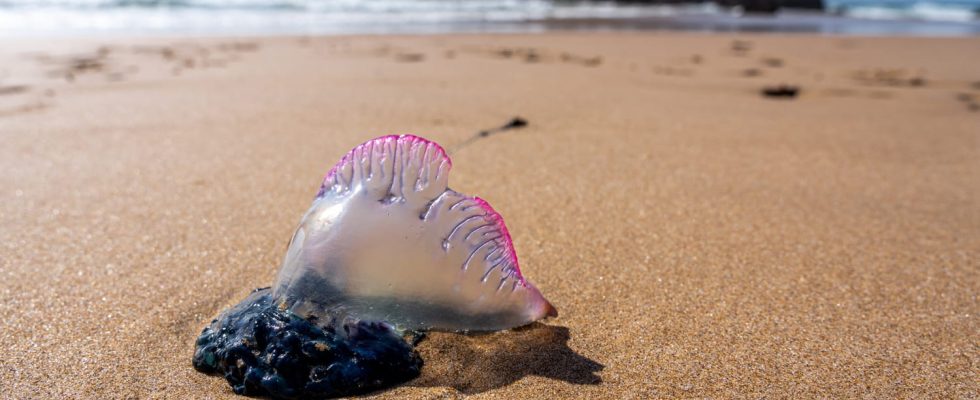The physalia (or sea bladder) is a marine animal close to the jellyfish, present on the beaches of the Atlantic coast in France (Landes, Vendée, Brittany, etc.). You should not touch it because it is extremely stinging.
Physalia (Physalia physalis), also called “Portuguese galley” Or “Spanish galley” Or “sea bladder” is a marine animal that resembles strongly to a jellyfish. Its filaments are extremely stinging and can cause burns if touched. Physalia is frequently observed on the beaches of the French Atlantic coast, notably in Vendée, Loire-Atlantique, Aquitaine and more rarely, in Brittany. In mid-July 2023, the presence of physalia in swimming areas forced the authorities to close six beaches.Anglet and Biarritz. So, if you notice their presence, you should not touch them, even if they are dead or stranded because they remain dangerous.
Watch out for Physalia!
It’s not a jellyfish, but it’s still very stinging. It is present on the coast
Do not touch stranded animals and in the event of envenomation follow the recommendations
If symptoms consult a doctor
https://t.co/cn8oAWJqFQ pic.twitter.com/M0HJkcTDqw— ARS Pays de la Loire (@ars_pdl) January 6, 2023
The physalia is close to the jellyfish, even if it is not the same marine animal. It presents a characteristic form of air-filled bag, measuring 15 to 20 cm. She is colored pinkish or bluish and equipped with filaments of great length (they can reach 15 to 40 meters), which are extremely stinging and can break easily and drift with the waves. It floats out of the water and can easily be confused with a plastic bag or a beach ball.
Where is it present in France?
At the start of 2023, theRegional Health Agency of Pays de la Loire reported the presence of physalia on the coast of Pays de la Loire (communes of Jard sur Mer, Talmont St-Hilaire, Piriac sur mer and La Turballe in particular), but it is also present on the coasts of Aquitaine and Charente- Maritime. In July 2023, several beaches in the Basque Country (Anglet, Biarritz, etc.) had to close and prohibit swimming due to the presence of physalia. On the other hand, its presence on the Breton coasts remains rare.
What are the dangers of a snail bite?
Contact with the filaments of a physalia can cause very painful skin lesions with a burning sensation or electric shock, orhives that can last for several hours. Small blisters may form on the skin, which turns purplish, and last for a few weeks. More general symptoms are possible: feeling unwell, loss of consciousnessincreased heart rate and blood pressure, dizziness, abdominal painvomiting… In 10% of cases, these symptoms are serious and require hospitalization.
What to do to relieve a physalia sting?
In the event of contact with a physalia, the Pays de la Loire Regional Health Agency recommends:
- Rinse with sea water without rubbing
- Do not apply heat (heat exaggerates the burn) even if the venom is sometimes heat labile
- Remove, without crushing them, the visible filaments with pliers or a double glove,
- Apply shaving foam or, failing that, dry sand (especially not wet), scrape with a credit card or rigid cardboard
- Consult a doctor or call SAMU Center 15 when the general symptoms listed above appear
If you notice the presence of these animals on the beach, it is recommended not to swim or practice water sports involving frequent contact with water (such as windsurfing, kite surfing, etc.). It is also recommended not to touch the animal, even if it is stranded or dead. because The stinging cells of jellyfish can remain active for several days.
